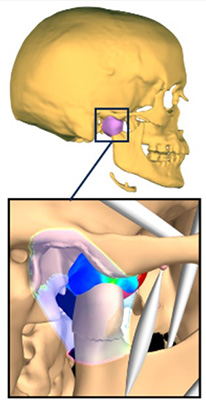Biomechanical Modeling of the Temporomandibular Joint
 Biomechanical computational modeling is a powerful tool to evaluate multi-factorial effects on functional outcomes in a simulated environment, which cannot be directly measure in humans. Simple models have investigated the ability of the temporomandibular joint (TMJ) lateral capsule ligament (LCL) complex to maintain physiological approximation of TMJ articular components but have severe limitations; previous models reduce the LCL complex to a simple band, are not reflective of true material properties, do not utilize a complex modeling approach, or are limited to 2 dimensions. We will be developing 3D subject-specific computational models to evaluate differences in stress-strain distributions by sex and race that may contribute to associated disparate rates of joint dysfunction. To our knowledge, these will be the most complete 3D finite element TMJ models to assess restraining forces during physiologic oral tasks.
Biomechanical computational modeling is a powerful tool to evaluate multi-factorial effects on functional outcomes in a simulated environment, which cannot be directly measure in humans. Simple models have investigated the ability of the temporomandibular joint (TMJ) lateral capsule ligament (LCL) complex to maintain physiological approximation of TMJ articular components but have severe limitations; previous models reduce the LCL complex to a simple band, are not reflective of true material properties, do not utilize a complex modeling approach, or are limited to 2 dimensions. We will be developing 3D subject-specific computational models to evaluate differences in stress-strain distributions by sex and race that may contribute to associated disparate rates of joint dysfunction. To our knowledge, these will be the most complete 3D finite element TMJ models to assess restraining forces during physiologic oral tasks.
